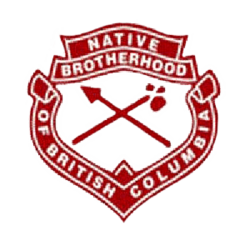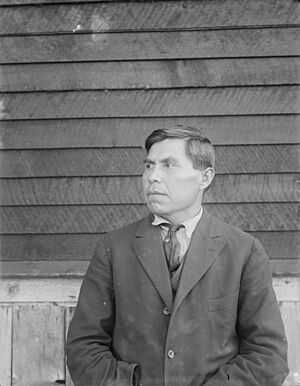Native Brotherhood of British Columbia facts for kids

Logo of the Native Brotherhood of British Columbia
|
|
| Abbreviation | NBBC |
|---|---|
| Formation | December 13, 1931 |
| Founder |
|
| Founded at | Port Simpson, British Columbia, Canada |
| Type | Nonprofit |
| Purpose | First Nations rights in British Columbia |
|
Region
|
British Columbia |
| Subsidiaries | Native Fishing Association |
| Secessions | North American Indian Brotherhood |
| Website | https://nativebrotherhood.ca/ |
The Native Brotherhood of British Columbia (NBBC) is an important group for First Nations people in British Columbia. It was started in 1931. Its main goal was to help improve the lives and economic situations of First Nations communities in BC.
At first, the NBBC focused on money problems. This was especially true for coastal First Nations who worked in fishing. The Great Depression had made things very hard for them. Most early members were from northern coastal communities, like the Haida and Tsimshian peoples.
After the Second World War, the Brotherhood grew a lot. It started including communities from more parts of British Columbia. As the group became more influential, it began to work on bigger social issues. These included things like education, housing, and fighting against unfair rules. By then, the Brotherhood was one of Canada's most important Indigenous organizations. It played a key role in standing up for the rights of First Nations. Today, in 2025, the Brotherhood is still one of Canada's oldest active Indigenous groups.
Contents
History of the Brotherhood
How the Brotherhood Started
In the summer of 1931, Alfred Adams, a leader from the Massett Haida community, met with some Tsimshian and Haida fishermen. They were waiting out a storm on Langara Island in Haida Gwaii. Alfred Adams knew about the Alaska Native Brotherhood from his visits to Alaska. He suggested starting a similar group for different First Nations in BC. This new group would focus on the money problems faced by First Nations fishermen. These problems were caused by the Great Depression. This first meeting led to more talks between Adams and Tsimshian leaders that fall. These talks helped set up the first official meeting.
The first meeting of the Brotherhood happened on December 13, 1931. It took place at the Salvation Army hall in Lax Kw'alaams. The meeting started with a song, then a full day of speeches. Alfred Adams spoke about how important it was for everyone to work together. In the following days, they wrote a request to send to the government in Ottawa. They also set up the organization based on European fraternal groups. Representatives from six communities attended: Gitga'at, Gitxaala, Kitselas, Metlakatla, Massett, and Lax Kw'alaams. Alfred Adams, William Beynon, Chief William Jeffrey, and Guy Williams were some of the people who helped start the group.
The new organization asked for better working conditions for First Nations fishermen. They also wanted better education, and fair hunting, fishing, and trapping rights. They also asked for rights to harvest timber on lands not part of reserves. These requests were very similar to those of an older group called the Allied Tribes of British Columbia. However, the Brotherhood avoided directly asking for land claims, which was not allowed at the time.
In the years that followed, the Brotherhood slowly grew to include more communities. By 1936, groups from Kitasoo, Heiltsuk, Nuxalk, Haisla, Kispiox, Gitwangak, Gitsegukla, and Gitanmaax had joined.
The Brotherhood During the Second World War
During the Second World War, the Canadian government made new rules. These included requiring people to join the military and making First Nations commercial fishermen pay income tax. These changes caused more people to join the Brotherhood. In 1942, the Brotherhood joined with the Pacific Coast Native Fishermen's Organization. This group was mostly made up of Kwakwaka'wakw members. This merger helped the Brotherhood focus more on fishing rights. In the same year, the Nisga'a people also joined. This was partly because Frank Calder was friends with Alfred Adams' son.
In 1945, Andy Paull, who was a manager for the Brotherhood, left the group. This happened after there were concerns about how money was being handled. After this, some chapters of the Brotherhood, mainly from Coast Salish communities, left to form the North American Indian Brotherhood.
The Native Voice Newspaper and Government Committee
In 1946, the Brotherhood started its own newspaper called The Native Voice. This was something the late president, Alfred Adams, had wanted. Maisie Hurley was the editor. It became the official newspaper for the Brotherhood. At that time, it was the only Indigenous newspaper in British Columbia.
In 1947, the Brotherhood sent representatives to Ottawa. They took part in a special committee made up of members from the Senate and House of Commons. This committee was looking at changing the Indian Act. The Brotherhood's group was invited to speak in May 1947. The group included President William Scow, Rev. Peter Kelly, Thomas Gosnell, and Guy R. Williams. They argued that the government should stop controlling First Nations so much. They believed First Nations could be more independent. They also criticized the government for making First Nations pay taxes without having a say in government decisions. The Brotherhood's ideas helped a lot with the changes made to the Indian Act in 1951.
In 1985, the NBBC created the Native Fishing Association. This group aimed to help First Nations people get more involved in commercial fishing. It did this by offering low-interest loans and training programs.
Leaders of the Brotherhood
| Term | President | Source |
|---|---|---|
| 1932–1945 | Alfred Adams | |
| 1945–1954 | William Scow | |
| 1954–1960 | Robert Clifton | |
| 1960–1972 | Guy Williams | |
| c. 1974–1977 | John Clifton | |
| 1977–1988 | Edwin Newman |
Lasting Impact
The story of how the Brotherhood started in BC is told in a 2017 musical documentary. It was made by North Vancouver filmmaker Marie Clements. The film is called The Road Forward.


